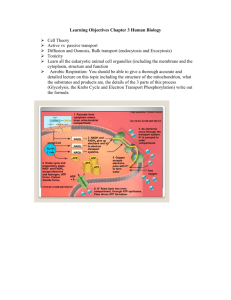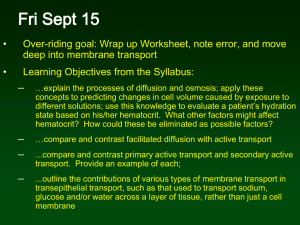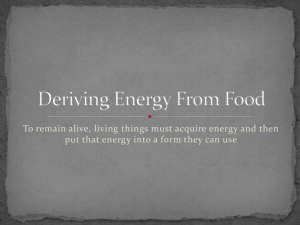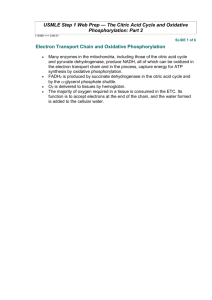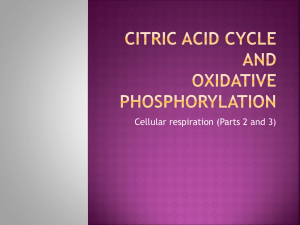File
advertisement
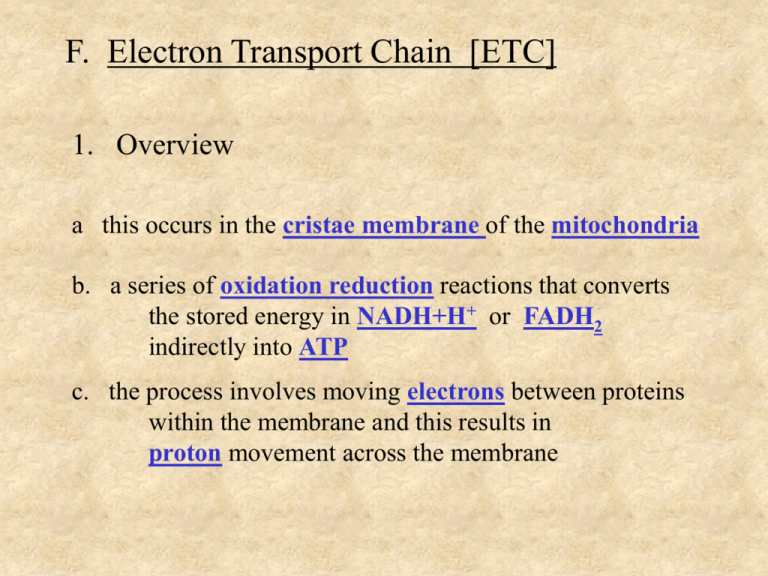
F. Electron Transport Chain [ETC] 1. Overview a this occurs in the cristae membrane of the mitochondria b. a series of oxidation reduction reactions that converts the stored energy in NADH+H+ or FADH2 indirectly into ATP c. the process involves moving electrons between proteins within the membrane and this results in proton movement across the membrane 2. Accessing the NADH+H+ and FADH2 Kreb’s cycle occurs in mitochondrial matrix 2 x 3 NADH+H+ 2 x 1 FADH2 oxidation of pyruvate occurs in mitochondria matrix 2 x 1 NADH+H+ glycolysis occurs in the cytoplasm 1 x 2 NADH+H+ 3. Getting the energy into the mitochondria from the cytoplasm NADH+H+ from the cytoplasm can not pass through the inner mitochondrial membrane and therefore can not directly enter the ETC however, the energy stored in NADH+H+ can be passed across the membrane with the electrons to a molecule of FADH2 glycerol phosphate shuttle protein NADH+H+ 2H+ 2e- NAD+ FAD FADH2 inner mitochondrial membrane ELECTRON TRANSPORT CHAIN 1 – NADH dehydrogenase 4 – cytochrome C 2 – protein Q 5 – cytochrome oxidase 3 – cytochrome b-c1 6 – ATP synthase 4 1 3 2 5 6 2H+ 2H+ 2H+ 2H+ 4 1 3 5 6 2 2e- FADH2 NADH + H+ ½ O2 + 2H+ FAD NAD+ 2H+ H20 2H+ ADP + Pi 2H+ ATP 2H+ 4. Proteins a. NADH dehydrogenase – accepts 2 electrons from NADH+H+ and passes them on - 2 H+ [protons] follow the electrons & pass through the membrane b. protein Q - accepts 2 electrons from NADH dehydrogenase or FADH2 and passes them on c. cytochrome b-c1 complex - accepts 2 electrons from protein Q and passes them on - 2 H+ [protons] follow the electrons & pass through the membrane d. cytochrome c - accepts 2 electrons from cytochrome b-c1 complex and passes them on e. cytochrome oxidase complex - accepts 2 electrons from cytochrome c & passes them on to oxygen [1/2 O2] - 2 H+ follow the electrons & pass through the membrane 6. tally of H+ across the membrane a. for every NADH+H+ 3 pairs of H+ are pumped into the intermembrane space b. for every FADH2 2 pairs of H+ are pumped into the intermembrane space 7. ATP synthetase [not technically part of the ETC] a. there are more H+ in the intermembrane space than in the matrix b. the H+ try to move down a concentration gradient back across the membrane c. the H+ can not pass through the phospholipid membrane directly d. the enzyme ATP synthetase allows the H+ to pass through it e. as the H+ pass through the ATP synthetase they distort its shape and when it returns to its normal shape it is able to add Pi + ADP ATP + H2O 8. Summary pg 108 Fig. 22 for information 9. Overall summary pg 110 Fig 25 recommend copying this SUMMARY OF PHOTOSYNTHESIS and AEROBIC RESPIRATION chloroplast glucose mitochondria light CO2 light reaction C-4 cycle ATP; NADPH +H+ Calvin cycle H2 O chloroplast O2 cellulose glucose glucose O2 ATP H2 O NADH + H+ FADH2 ETC glycolysis pyruvate CO2 FAD NADH + H+ NADH + H+ FADH2 oxidation of pyruvate Kreb’s cycle mitochondria ATP ATP CO2

